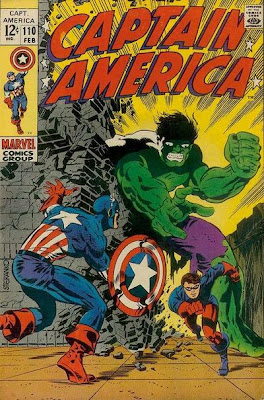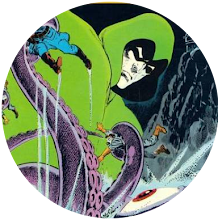It does however give me an excuse to look at his most famous creation - Captain America - and take a look at one of that strip's most celebrated phases, the short period when it was drawn by Jim Steranko.
I have to admit I've not always been sold on Steranko's work, sometimes finding it too like an exercise in graphic design rather than heart-felt story-telling but even I have the taste to have always appreciated his stint on Captain America. And issue #110 was where it started.
It all starts when Steve Rogers is roaming the city at night, minding his own business, when none other than the incredible Hulk smashes through a brick wall. During Cap's tangling with the monster, Rick Jones shows up, gets injured and - unconscious - has to be taken back to Cap's flat. Once recovered, Rick declares he wants to take Bucky's place, and goes with our hero on his next mission, a subterranean battle with Hydra who're out to contaminate the city's water supply. Needless to say Cap sees off this threat to New York - and a new partnership is born.
What leaps out at you about this issue is what a complete and total weener Rick Jones is - and, frankly, what a nut-job. Upon waking in a strange apartment, his first reaction to seeing a dead crime-fighter's costume is to put it on and parade around in it in front of that dead man's guilt-stricken ex-partner. Not only is this presumptuous but plain weird. Who upon finding a dead man's clothing feels compelled to put it on? He then whines and grizzles his way though the rest of the tale, managing to mess up everything Captain America does, and leaving you wondering why Cap doesn't just smack him in the mouth like he's asking for.
But if Rick Jones and Madame Hydra are the characters who drive the tale, overall it's dominated by Jim Steranko and his work. Aided by Joe Sinnott's clean inking, it's a beautiful thing to look at. But, also, Steranko's determinedly stylish layouts lend the story an atmosphere that, for some reason, brings to my mind the classic 1950s' sci-fi flick Invaders From Mars. Not because there's any similarity in either the look or content of the thing but because it shares the strangely surreal air of that movie. It seems odd to speak of sound when reviewing a story told in purely visual terms but there's a strange silence to Steranko's work, that lends a sterilising and haunting feel to things, almost as though what we're reading is some twenty page dream that Captain America's going through.
Perhaps a sign of how much Steranko's thinking's dominated by style rather than story is that, when we first meet Cap in the back alley, he's lighting a cigarette and having a smoke. It makes no sense at all in terms of character. Does the most physically perfect specimen of manhood, whose body is a presumably a well-honed temple, really smoke?
Of course he shouldn't and of course he doesn't but it looks stylish, so it gets used. Such liberties with the basic nature of a character should be unforgivable but the story's surreal air allows Steranko to get away with it, thanks to the feeling that we're seeing some sort of alternate version of Captain America to the one we're used to.











































































7 comments:
(Oh, come on Steve - it was a HERBAL cigarette.) Marvel UK released a nice hardback Annual back in the late '70s or early '80s devoted to Steranko's CAP. It featured this story. You can still see the Kirby influence in Steranko's work here, mainly in the stances of his figures.
At another blog that mentioned censorship in comics, it was pointed out that in this issue of CA, the Comics Code drew the line at whips, so that if you look at the panel you've reproduced, Madame Hydra is actually carrying a length of rope.
B, I did wonder why it looked so rope-like in close-up.
It's the next issue, No 111, that has one of the most iconic covers of that era. It truly transports one back to a time and a place.
The Comics Code restricted Madame Hydra to a length of rope, but somehow Catwoman was allowed to use a whip on the cover of Batman #197.
Captain America #110 was, in fact, the first appearance of Madame Hydra. Supposedly, one side of her face was badly scarred, which was why she wore her hair hanging over it. In later appearances, though, it had apparently healed, or been restored by plastic surgery.
She turned up in later issues of various Marvel comics, masterminding terrorist plots and fighting Cap, Wolverine, and other heroes. In her later appearances, she was renamed Viper.
Thanks for the Madame Hydra info, Anonymous.
Post a Comment